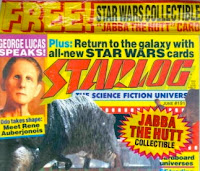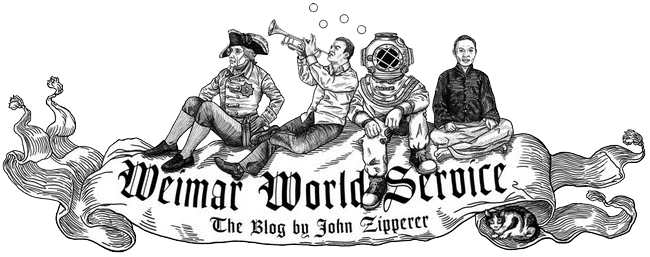The film would gross more than $350 million over the course of the next year, and it would spawn two sequels and a zillion imitators, which would fill up an entire year of SyFy Channel programming if played one after the other. It’s why Jim Wynorski can afford to pay his mortgage. (Wynorski even has a film called Piranhaconda, I kid you not.) It would spur an even more important development in the science-fiction film world, for it was the incredibly lifelike dinosaur computer-generated imagery (CGI) that would confirm in George Lucas’ mind the contention that the technology was now mature enough to let him make the Star Wars prequels the way he wanted.
Jurassic’s imitators steadily devolved into Crocosaurus types of things. Death Shark vs. Megasaurus sorts of SyFy schedule-fillers. Sharktopus vs. Squidgod, maybe even. Need I go on? But that should not cloud our minds to the fact that Jurassic Park was an amazing film, not just when it came out but still today. The story is fairly straightforward; the action is exciting; the characters are endearing; but most of all, it was the closest any of us got to seeing a real dinosaur, thanks to the amazing effects. I’m a book-lover first, but there is a visual treat that only films can deliver, and when they do so like Spielberg’s film here, they really earn Hollywood its reputation as a wonder factory.
Starlog #191
84 pages (including covers)
Cover price: $4.95
 A curious premium came with this issue. Buyers of Starlog #191 at retail stores purchased a polybagged magazine with a free Star Wars trading card included. Pretty cool. But those of us who were loyal enough to subscribe to the magazine did not receive a free trading card. We just got the magazine itself in the mail. Generally, publishers (to use a horrid word from the world of marketing) incentivize subscriptions, but for whatever reason, Starlog incentivized newsstand buyers, which after all have always made up the overwhelming percentage of its paid circulation.
A curious premium came with this issue. Buyers of Starlog #191 at retail stores purchased a polybagged magazine with a free Star Wars trading card included. Pretty cool. But those of us who were loyal enough to subscribe to the magazine did not receive a free trading card. We just got the magazine itself in the mail. Generally, publishers (to use a horrid word from the world of marketing) incentivize subscriptions, but for whatever reason, Starlog incentivized newsstand buyers, which after all have always made up the overwhelming percentage of its paid circulation.The rundown: Jurassic Park is featured on the cover, in case you haven’t figured that out so far. And a large photo of Sean Patrick Flanery’s Young Indiana Jones is on the contents page. David McDonnell’s Medialog reports that a seventh season of Star Trek: The Next Generation will be produced, but word is still out on the (soon to be very short-lived) Space Rangers. Michael McAvennie’s Gamelog reviews Superman from Sega Genesis, LIN’s Spider-Man/X-Men in Arcade’s Revenge (which has one of the most complicated titles in game history), and other superhero-themed games. Letters to the Communications pages include comments about (I know this’ll surprise you) Star Trek, a plea for a stay of execution for Space Rangers, and more, including Mike Fisher’s Creature Profile of the Fly.
 In his Videolog column, David Hutchison notes the release of Little Nemo: Adventures in Slumberland, which has apparently “lost in the translation” much of creator Winsor McCay’s “dreamlike graphic fantasies,” which sounds like a real shame, because the Little Nemo Sunday comics from the early decades of the 20th century are absolute must-see works of comic art. Nemo is up there with Krazy Kat, Calvin and Hobbes, and very few others in the pantheon of staggeringly perfect comics. Booklog reviews Snow White, Blood Red, Card Sharks, Warstrider, The Gripping Hand, The Hand of Chaos, Rediscovery, Salamandastron, If at Faust You Don’t Succeed, An Earthly Crown, Throy, and Ecstasia. The Fan Network pages includes the convention calendar and the directory of fan clubs and publications, now assembled by Scott Briggs. And in his From the Bridge column, Kerry O’Quinn pays tribute to futurist Buckminster Fuller.
In his Videolog column, David Hutchison notes the release of Little Nemo: Adventures in Slumberland, which has apparently “lost in the translation” much of creator Winsor McCay’s “dreamlike graphic fantasies,” which sounds like a real shame, because the Little Nemo Sunday comics from the early decades of the 20th century are absolute must-see works of comic art. Nemo is up there with Krazy Kat, Calvin and Hobbes, and very few others in the pantheon of staggeringly perfect comics. Booklog reviews Snow White, Blood Red, Card Sharks, Warstrider, The Gripping Hand, The Hand of Chaos, Rediscovery, Salamandastron, If at Faust You Don’t Succeed, An Earthly Crown, Throy, and Ecstasia. The Fan Network pages includes the convention calendar and the directory of fan clubs and publications, now assembled by Scott Briggs. And in his From the Bridge column, Kerry O’Quinn pays tribute to futurist Buckminster Fuller.Ian Spelling interviews actor Rene Auberjonois, who portrays the shapeshifting alien Odo on Star Trek: Deep Space Nine. Craig Chrissinger talks with actress Elizabeth Alexander, who portrays “holographic feminist” Selma on Time Trax. Clearly attempting to rub in the fact that I didn’t get a free trading card with my issue of #191, Bob Maschi provides an overview and select price guide for science fiction trading cards. To inflict further insult, Kyle Counts then examines the Star Wars Galaxy trading cards, assembled by Gary Gerani, who wrote for Starlog in its early years.
Ian Spelling gets the big interview this month: Producer George Lucas talks about his TV series The Young Indiana Jones Chronicles. Jurassic Park producer Kathleen Kennedy tells writer Bill Warren about the film’s long road to production, including getting all of the much-ballyhooed special effects right. Bill Florence chats with James Schmerer, who wrote the “Survivor” episode of the animated Star Trek in 1973 even though he most definitely doesn’t write animation. Stan Nicholls interviews author Kim Stanley Robinson, who discusses his Red Mars/Green Mars/Blue Mars books, including hearing from an envious Arthur C. Clarke.
Pat Jankiewicz profiles actor Claude Earl Jones, who discusses his roles in T.J. Hooker, M*A*S*H, Quantum Leap, and his interaction with fellow star William Shatner in the miniseries Centennial: “Fight scenes are very carefully choreographed, but even if they are, sometimes people get hurt. ... I would never hurt anybody deliberately, but I laid one on him, right on the nose. He was supposed to be moving out, but I’m a big man and when I hit you, you stay hit.” Jankiewicz also talks to Robert Lewin about his role as a writer/producer on Star Trek: The Next Generation (but he never slugged Shatner). And instead of his usual Liner Notes column, editor David McDonnell turns over two pages to “trading cards” featuring Starlog staffers Scott Briggs, Jim McLernon, David Hutchison, Maureen McTigue, and McDonnell himself. At least I got those trading cards.
“I do have a time line and it all fits together. Ultimately, the entire series [of The Young Indiana Jones Chronicles], which is now about 32 hours, although I have 70 hours worth of scripts, all fits together. You could actually go from end to end and it all connects. The shows aren’t being aired that way. They’re being shown randomly, and they’re being shot randomly, too. There’s a whole story there that starts with Indy as a five-year-old, and it carries him from before his trip with his father to after he comes back. Then it takes him to high school. … It goes through all the spy things, then college, and then what happens to him after college. As a whole piece, it’s a lot of fun because you can follow his life, and that’s very interesting.”For more, click on Starlog Internet Archive Project below or visit the Starlog Project's permanent site.
–George Lucas, producer, interviewed by Ian Spelling: “Life with Indy”



No comments:
Post a Comment